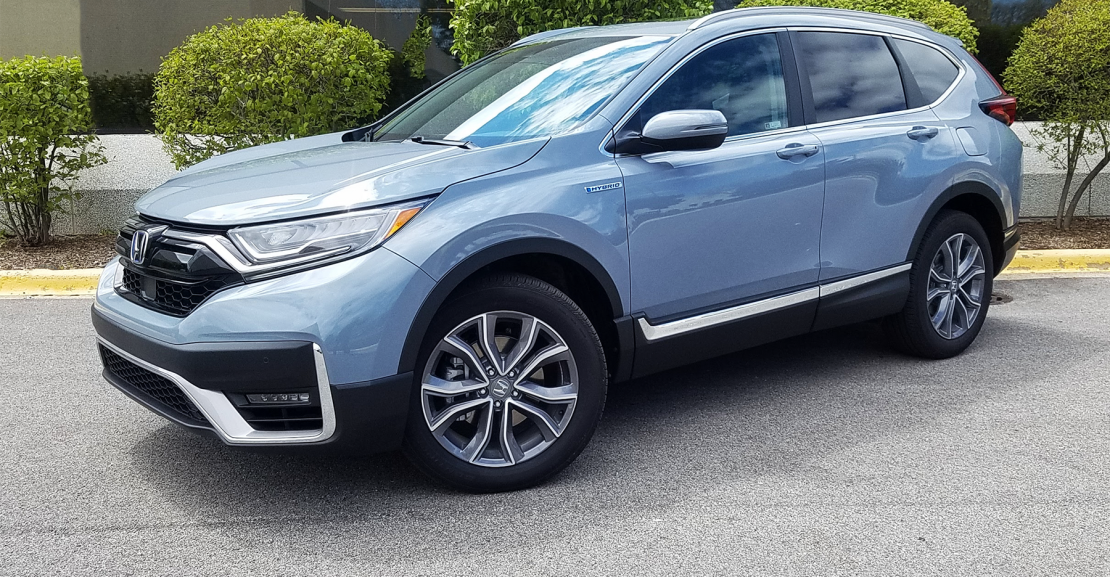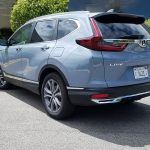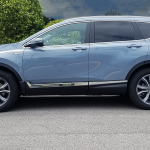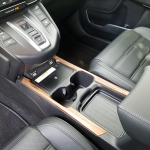
 2020 Honda CR-V Hybrid Touring
2020 Honda CR-V Hybrid Touring
Class: Compact Crossover SUV
Miles driven: 314
Fuel used: 8.6 gallons
| CG Report Card | |
|---|---|
| Room and Comfort | A |
| Power and Performance | B |
| Fit and Finish | A- |
| Fuel Economy | A |
| Value | B+ |
| Report-card grades are derived from a consensus of test-driver evaluations. All grades are versus other vehicles in the same class. Value grade is for specific trim level evaluated, and may not reflect Consumer Guide's impressions of the entire model lineup. | |
| Big & Tall Comfort | |
| Big Guy | B |
| Tall Guy | B+ |
| Big & Tall comfort ratings are for front seats only. "Big" rating based on male tester weighing approximately 350 pounds, "Tall" rating based on 6'6"-tall male tester. | |
| Drivetrain | |
| Engine Specs | 212-hp 2.0-liter |
| Engine Type | 4-cyl hybrid |
| Transmission | CVT |
| Drive Wheels | AWD |
Real-world fuel economy: 36.5 mpg
Driving mix: 45% city, 55% highway
EPA-estimated fuel economy: 40/35/38 (city/highway/combined)
Fuel type: Regular gas
Base price: $35,950 (not including $1120 destination charge)
Options on test vehicle: None
Price as tested: $37,070
Quick Hits
The great: Passenger and cargo space, ride quality, build quality, smoothness and fuel efficiency of hybrid powertrain
The good: Comfort and convenience features of Touring model
The not so good: Hybrid hardware eats up a bit of cargo space, some desirable features are restricted to high-end models
More CR-V price and availability information
John Biel
There now are more hybrid compact-crossover SUVs on the market than there are subpremium large cars, now that the Honda CR-V Hybrid has come out. The new gas-electric CR-V joins the Ford Escape, Toyota RAV4, Kia Niro, Mitsubishi Outlander, and Subaru Crosstrek in offering conventional and/or plug-in hybrids, and it does so in a roomy and feature-laden package that also delivers competitive fuel mileage.
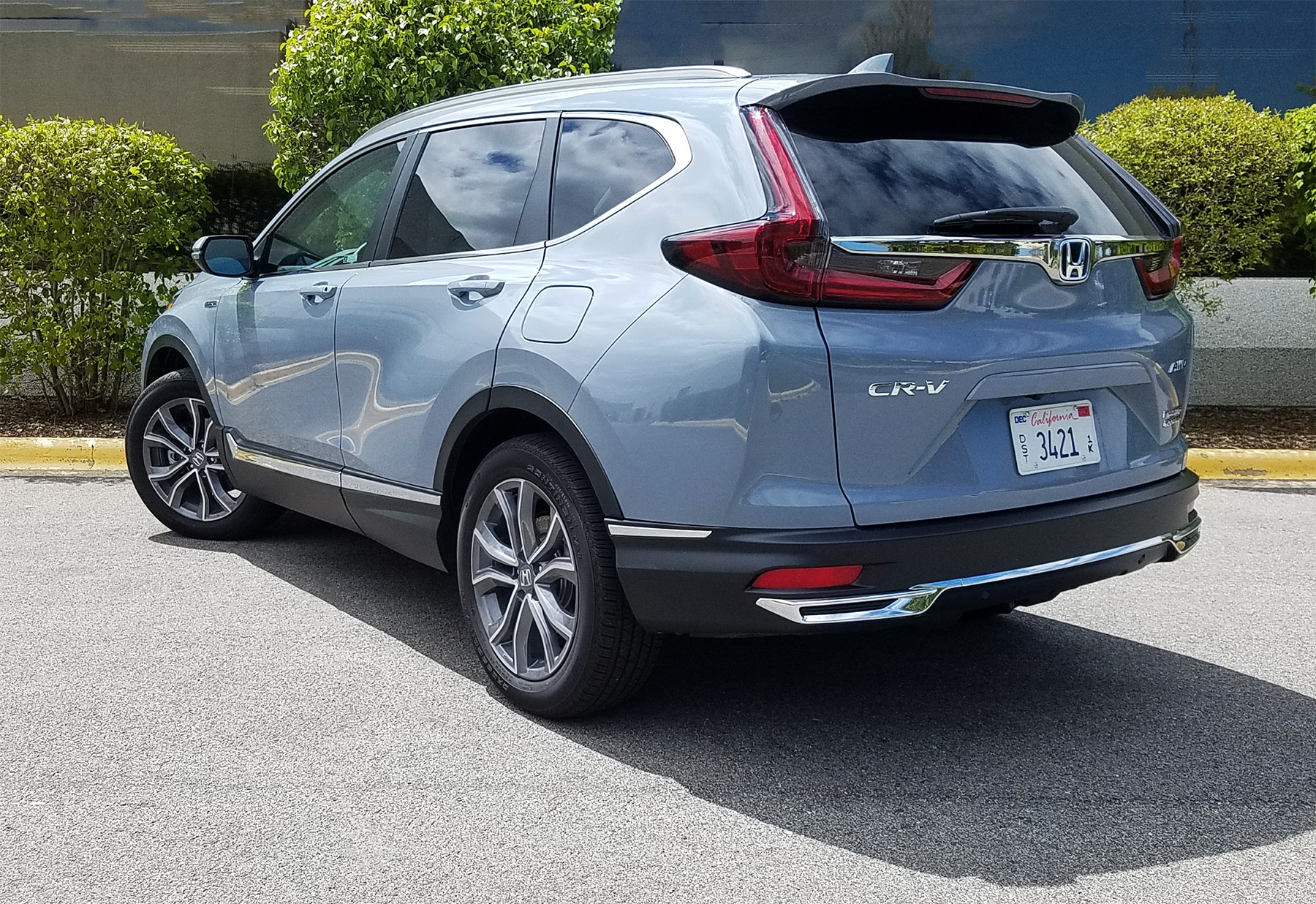
Honda is going in big, too. All four 2020 CR-V trim levels are available with hybrid power, which is generated by a synchronous permanent-magnet electric motor teamed with a 2.0-liter Atkinson-cycle 4-cylinder engine for a combined 212 horsepower at 6200 rpm. (The powertrain and battery are shared with the Accord Hybrid.) All-wheel drive is standard. Compared to AWD gas-engine CR-Vs of the same trim grade, hybrids cost $1225 more. Consumer Guide tested a top-level Touring priced at $37,070 with delivery.
The current CR-V generation was launched for 2017. It is freshened for ’20 with a revised front-end look, particularly in the bumper and lower intake; a new rear diffuser; and dark-tinted taillights. Even entry-level LXs now come with the Honda Sensing high-tech safety group of adaptive cruise control, collision-mitigation braking, lane-keeping assist, and road-departure mitigation.
Test Drive: 2020 Lexus UX 250h Luxury

The EPA rates the CR-V Hybrid at 40 mpg in the city, 35 mpg on the highway, and 38 mpg in combined city/highway driving. This reviewer’s stint in the test car outdid all those numbers at 41.6 mpg after a test of 82 miles that included 45 percent city-style operation, though our other editors didn’t achieve numbers quite that good.
While Honda claims the hybrid is a little quicker than the 190-horsepower turbocharged 4-cylinder gas-engine CR-Vs, there’s still more of a feeling of cool competence than hot-bloodedness to the dual-power job. Paired with an electronic continuously variable transmission, it has enough power for good street performance, and cruises safely in highway running when in the basic “ECON” drive mode. The transition from low-speed electric to higher-speed internal-combustion operation is delightfully seamless. “Sport” mode enhances throttle response to an obvious degree—and it presses the point home with a little more edge to the exhaust note. “EV” mode allows for driving solely on electric power for short distances when the battery is sufficiently charged. Paddles on the steering wheel may look like shifter paddles to work the transmission, but here they govern the level of regenerative braking that slows the car without pedal braking, while feeding the battery.
Test Drive: 2020 Ford Escape Hybrid
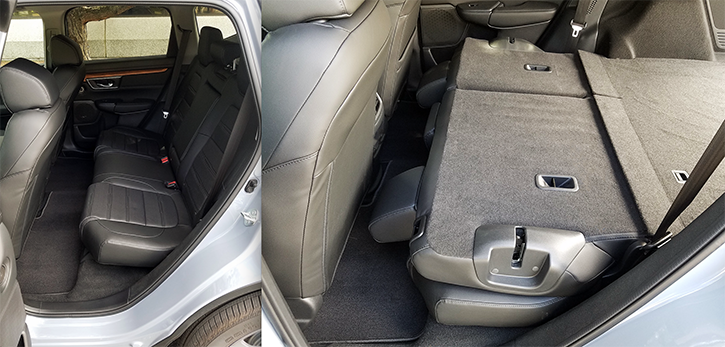
Even with the 19-inch alloy wheels standard on Tourings, tire sidewalls are still fairly high-aspect, so ride from the fully independent suspension is quite well composed and comfy. Bestowed with a thicker front stabilizer bar than full-gas models, the CR-V Hybrid steers and handles with ease and surety.
Passenger room is adult-friendly in both rows, and thanks to a flat floor, three grown-ups might be able to squeeze in across the rear seat. Doors open wide for unencumbered entry and exit in either row. The only flaw to befall driver vision—usually a Honda strong suit—is to the rear corners, where the body rises up to blend into the rear roof pillar. There’s good cargo space in back—33.2 cubic feet behind the second-row seat—just not as much as in a gas CR-V. The hybrid battery is located under the cargo floor, which prevents the hybrid from having the adjustable load floor found in other CR-Vs. Rear 60/40 seats fold flat and flush with the cargo floor for 68.7 cubic feet of available space.
Test Drive: 2019 Toyota RAV4 Hybrid Limited
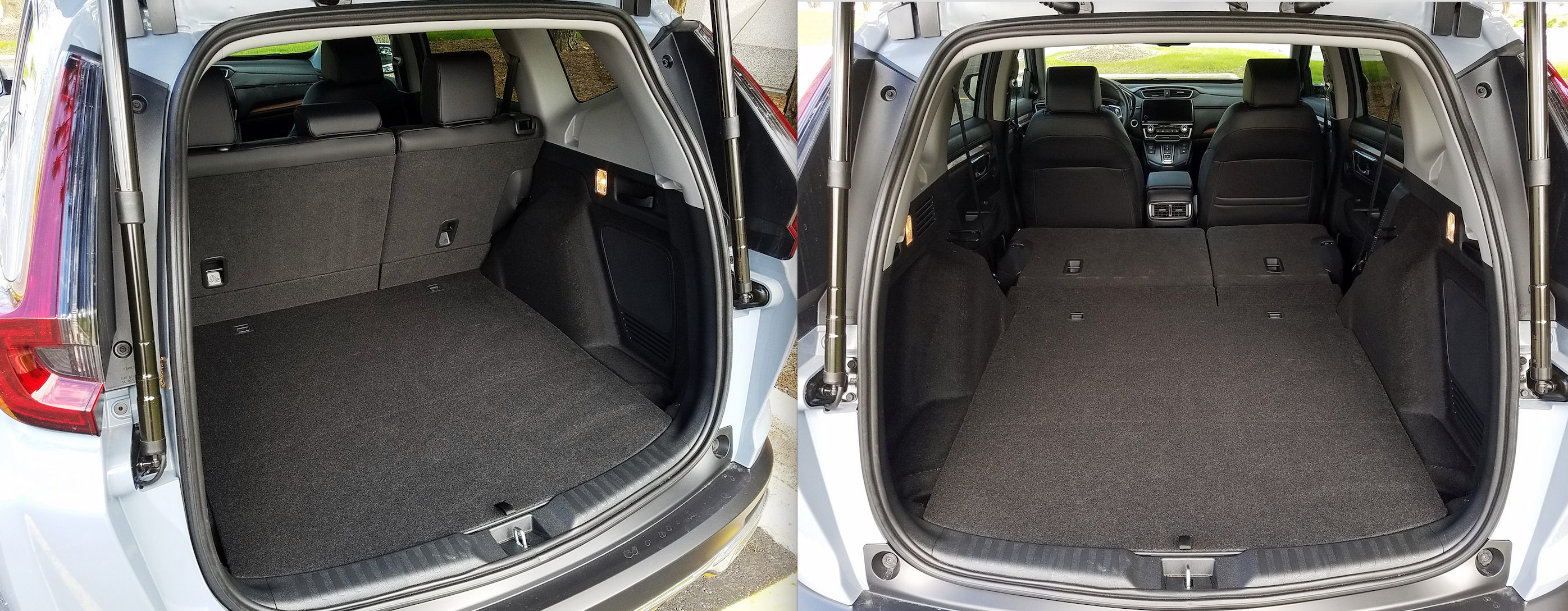
In addition to their specific powerteam, CR-V Hybrids also come with additional standard features, relative to the gas models, at each trim level. The Hybrid Touring’s bonus item is front and rear parking sensors. Hybrids also get a push-button gear selector (in place of the gas version’s stand-up shifter), and an instrument-panel display that can be configured to report power distribution and even hand out an efficiency “grade” after each trip.
Given Honda’s lack of option packages, Tourings come about as complete as a CR-V can be. Seats and steering wheel are leather-trimmed, and the front buckets and wheel are heated. The memory-function driver’s seat is power-adjustable 12 ways. Some of the built-in comforts and conveniences are remote engine start, rain-sensing windshield wipers, hands-free power liftgate, power moonroof, dual-zone automatic climate system, LED headlights with automatic high-beam control, keyless entry and starting, 9-speaker audio system, navigation, satellite and HD radio, Apple CarPlay/Android Auto smartphone integration, and Qi wireless charging (new to all Tourings for 2020). Additional safety features are rear cross-traffic alert, blind-spot alert, and a driver-attention monitor.
Test Drive: 2019 Hyundai Ioniq Plug-In Hybrid

Bright metal and woodgrain accents brightened the black interior that was the only color choice for CG’s Sonic Gray Pearl test vehicle. (Other interior colors are available, but only in combination with specific paints.) Soft-touch surfaces are found atop the instrument panel and front doors. Climate and audio controls are easy to work. Storage options for incidental items are good, but not outstanding: an ample glove box sited low in the dash, where it might open on a passenger’s knees; an open storage space in the console beneath a flip-up armrest; a single rear-seat storage pouch behind the front passenger seat; cup holders in the console and pull-down rear armrest; and large door pockets with bottle holders.
Honda is no novice in the hybrid field, having been there for 20 years. The CR-V joins the brand’s several electrified sedan offerings even as it spreads Honda’s wings a little bit by adding to the growing body of small sport-ute hybrids.
Test Drive: 2019 Mitsubishi Outlander PHEV
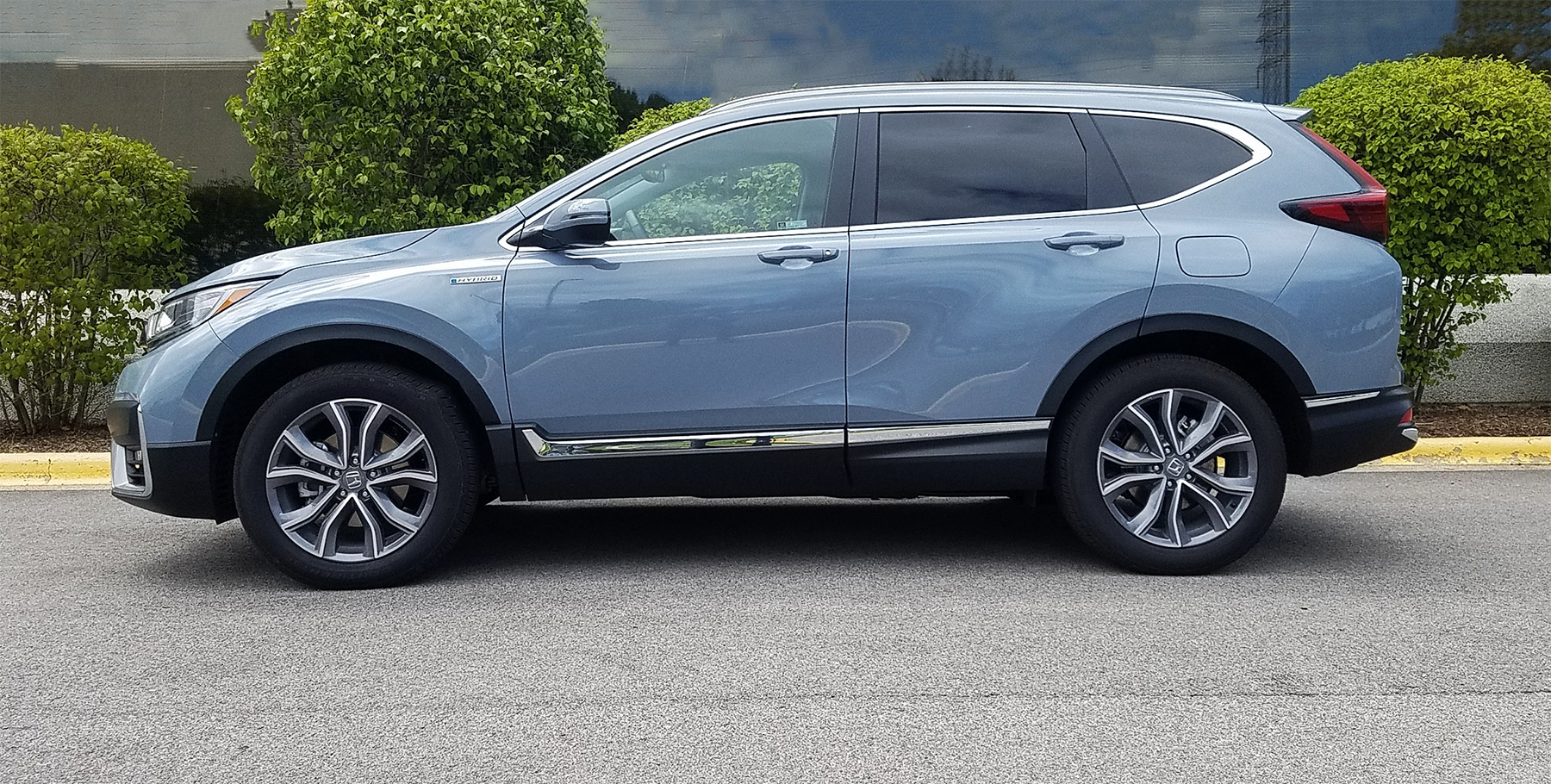
Check out the entertaining and informative Consumer Guide Car Stuff Podcast
2020 Honda CR-V Hybrid
2020 Honda CR-V Hybrid Gallery
2020 Honda CR-V Hybrid

